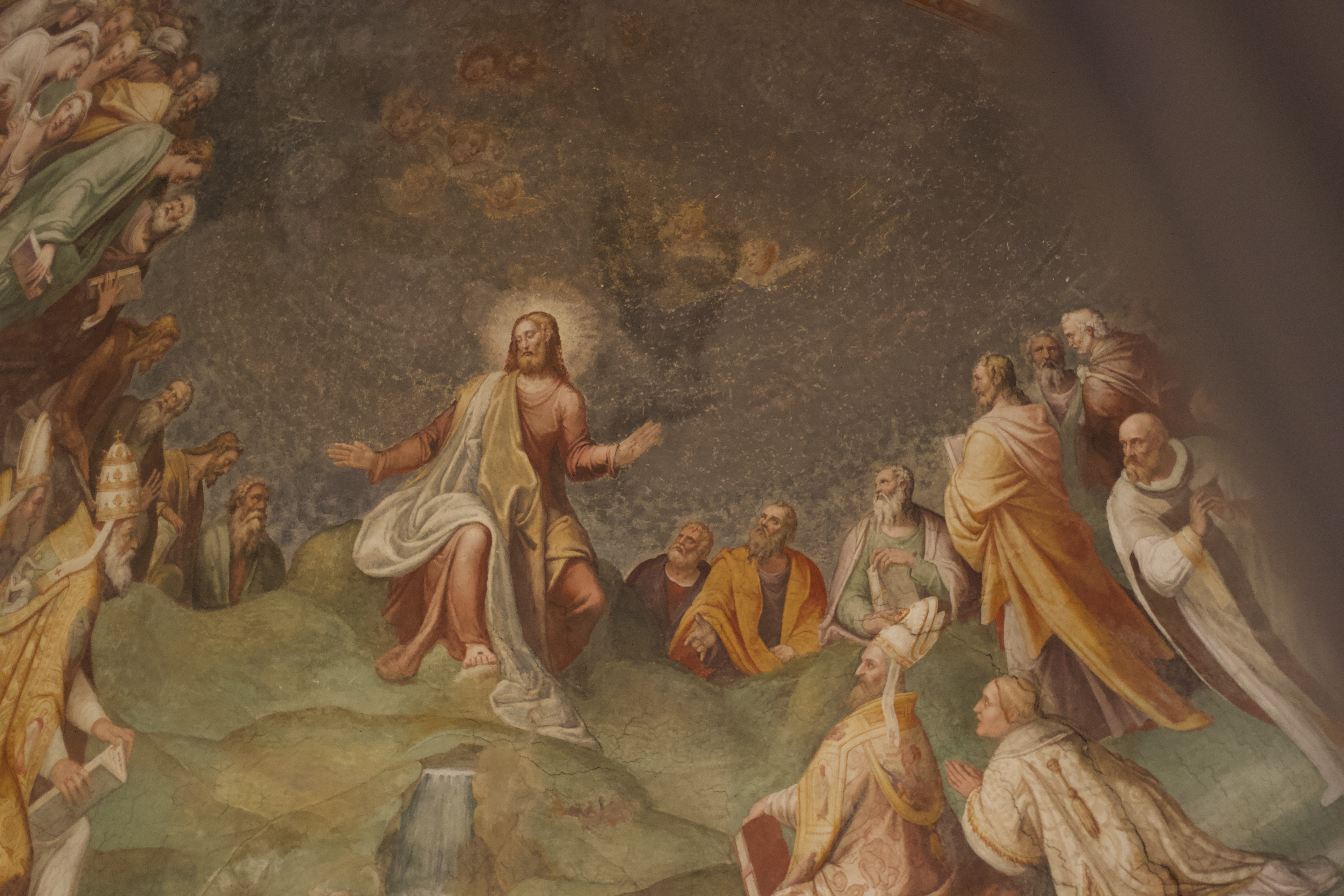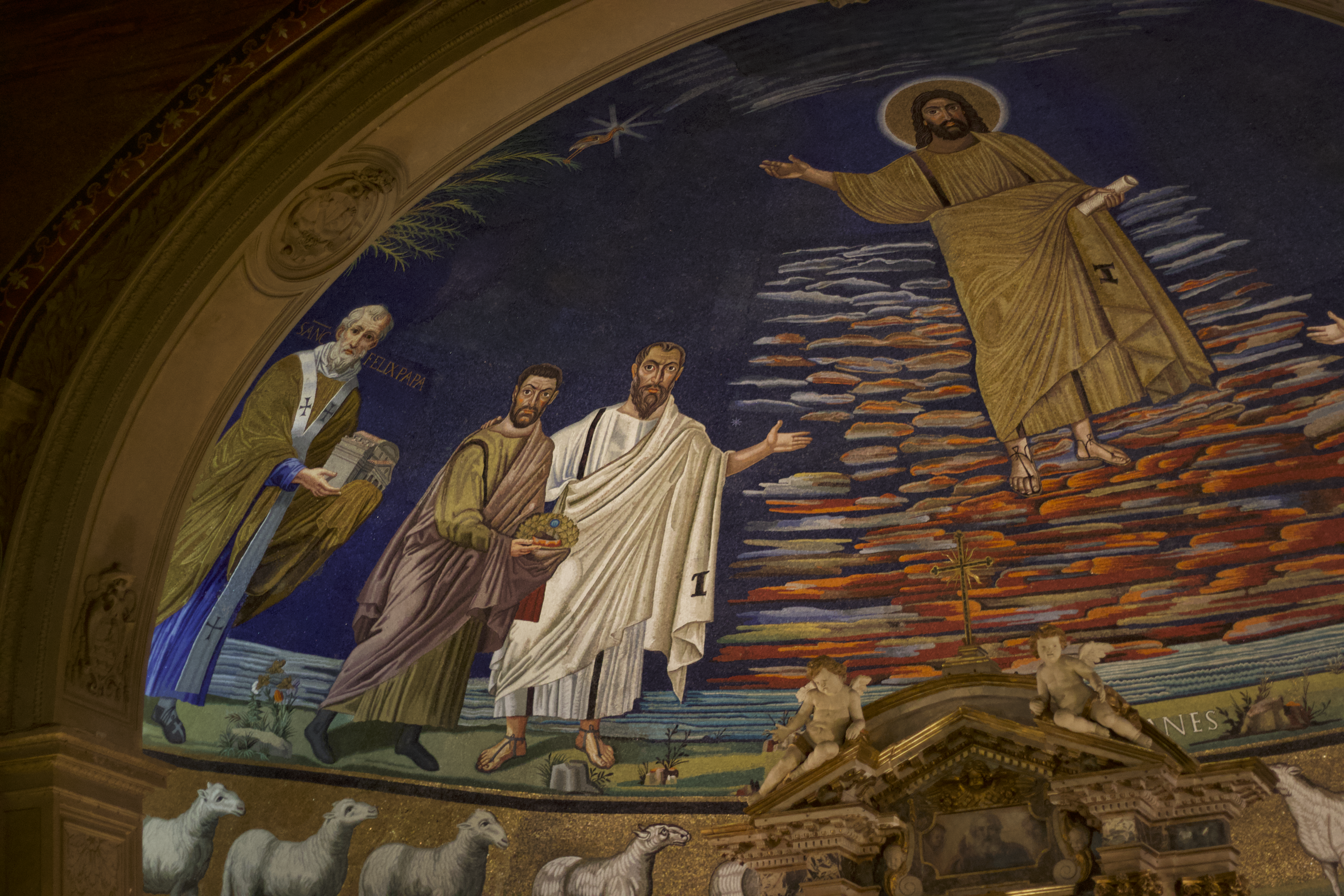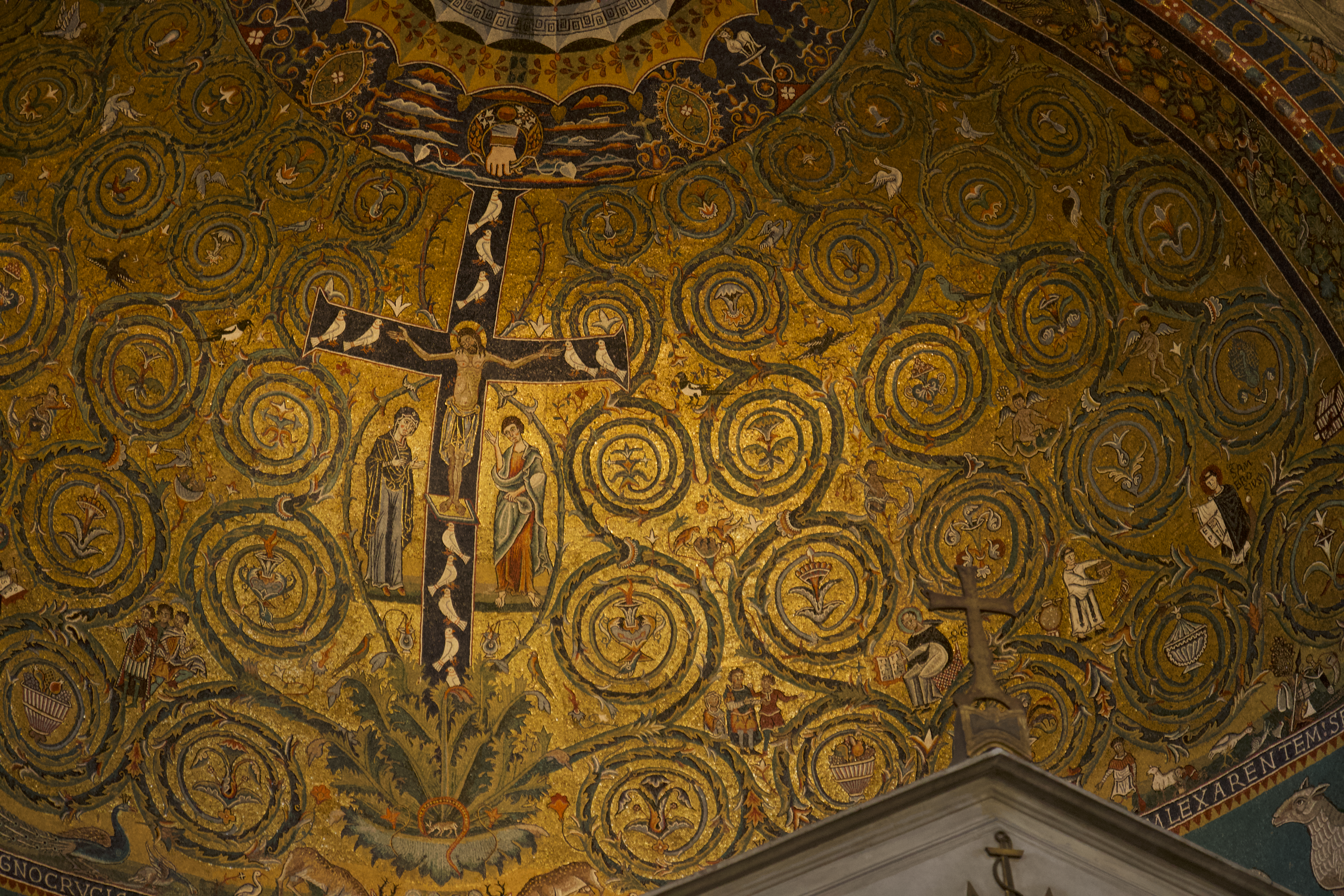I can see my breath inside the church of St. Balbina. Some 1,700 years ago this was prime real estate, just off Rome’s main thoroughfare, the Via Appia, an easy stroll to the Circus Maximus or the Baths of Caracalla. Today the sidewalk in front is weedy, and the church is tucked between the ruins of those baths and the spiked fence of a sprawling office complex belonging to the United Nations.
It is mid-Lent 2018. The day before, Rome experienced its first snowfall in half a decade, turning Bernini statues into angelic snowmen and provoking a fit of metaphoric excess in which I imagined the glittering frost covering the orange trees and umbrella pines as a kind of cosmic baptismal garment, hiding for a moment the Eternal City’s trash collection problem. The next day, the snow remains—as does the trash—and the early medieval church in which I am concelebrating a 7 a.m. Mass is frigid.
And still it is one of my favorite moments in the year’s pilgrimage toward Easter, perhaps because of the solidarity that arises among the determined few who have made it to this obscure outpost housing the relics of an equally obscure saint: St. Balbina, the virgin daughter of a martyred Roman tribune who, it is said, was cured of a goiter upon discovering the chains that once bound St. Peter.
Rome’s Lenten stations highlight aspects of the church’s yearly pilgrimage potentially neglected in our decidedly softer age.
I am following the ancient itinerary of Rome’s station churches, each morning trekking off to a different neighborhood seeking out churches built on the site of apostolic and legendary events—the home where Peter and Paul lived upon arriving in Rome; the room where Mark wrote his Gospel; the pit in which St. Lawrence was roasted; the spot the Blessed Virgin used another snowfall (this one miraculous) to reveal to Pope Liberius where to build St. Mary Major.
The liturgical scholar John Baldovin, S.J., posits that the practice of station liturgies emerged at a time when urban Christianity was growing in both size and complexity. They helped the bishop of a city—Jerusalem and Constantinople also developed station liturgies—unify his flock. The defining characteristic of the practice was that the bishop celebrated Mass each day in a different church, drawing Christians from other parts of the city together, highlighting the rhythms of the liturgical season and giving each neighborhood a chance to retell the local stories of martyrdom and courage that had by then become part of the fabric of early Christianity.

Stational liturgy in Rome has had its ups and downs. The century the pope decamped to France was a downswing; recent years have witnessed a resurgence. Today, the pope presides only at the first of the station churches, Santa Sabina on the Aventine Hill, but each morning the seminarians of the North American College conduct Mass in English at the other sites. The churches on the stational itinerary are among the city’s oldest—the Jesuits’ baroque masterpieces are a millennium too young to have made the cut—some well known, like St. Peter’s, others less so, like St. Balbina’s. But often enough the most obscure churches turn out to be the most fascinating. Those are the places you might find a garrulous custodian willing to open up locked sacristies or excavations or crypts beneath the altar.
Following the station churches from Ash Wednesday to Easter—in 2018 I hit every one—is a trip back into the first strata of Christianity: to the era of all those folks St. Paul greets at the end of the Epistle to the Romans; to the years when popes—along with soldiers, matrons, virgins, deacons, aristocrats, stonemasons—ended up as martyrs; to the fourth century, when, at last legally tolerated, Christians started building basilicas over the house churches in which they had worshiped during the decades of on-again, off-again persecution.
Besides helping us to appreciate the tradition from which we have come—and to get in our steps for the day—Rome’s Lenten stations highlight two other aspects of the church’s yearly pilgrimage potentially neglected in our own decidedly softer age, when one does not have to worry about being buried alive by pagans (St. Vitale), roasted in one’s own bath (St. Cecilia) or beheaded (St. Cecilia again—she survived the roasting).
Conversion
The first of these is the sense of conversion Easter should bring. Lent, after all, is preparation for the great festival of baptism, the Easter Vigil. Today, the sacraments of initiation are often enough mistaken for celebrations of life milestones—baptism for the celebration of a child’s birth, confirmation as a coming-of-age marker. I am told the story of a Muslim immigrant to Rome who went about planning a baptism for his firstborn, imagining that “baptism” was just a kind of Italian baby shower without any particular religious significance. The story may be apocryphal but, even so, is plausible enough to illustrate the problem. The sacraments are meant to initiate us into the paschal mystery, not provide the photo backdrop for a cultural get-together.
In the early church—when baptism meant immersion and then maybe martyrdom—this reality was harder to miss. All the movement in Rome’s stational liturgy also has a way of hinting at conversion. At St. Vitale, for example, the celebrant preaches about baptism, using the church’s peculiar geography to make his point. The church seems sunken in the ground because layers of the city have accumulated around it over the centuries; you have to descend a flight of stairs to enter. Descent is a key part of baptismal symbolism, immersion in the water joining us to Christ’s descent into the tomb.
The liturgies of Lent and Easter, like the churches themselves, are built upon the conviction that the resurrection changes everything.
Once inside, St. Vitale immerses you in martyrdom. The church, in fact, commemorates a family of martyrs: St. Vitale (dad), St. Valeria (mom), and Sts. Gervasius and Protasius (children). Other martyrs are more recent; this was the church assigned to the English bishop John Fisher when he was named a cardinal, only to be beheaded a month later by Henry VIII. The parish’s abundant collection of relics is on display, its sanctuary and side altars festooned with blood-red sashes. And—perhaps my favorite decorative touch on the station pilgrimage—fresh cut laurel branches are scattered over the floor. Laurel crowns are the mark of martyrdom in classic art, and the leaves fill the church with the fragrance of spring. In the tomb, Easter arrives.
And, of course, it is this knowledge of the resurrection that gave the martyrs their courage and causes the church to celebrate the anniversaries of their death as heavenly birthdays. Rome’s favorite martyr, after the apostles, is no doubt the deacon Lawrence. In Rome one can visit the sites of his imprisonment, trial, execution and burial, and churches dedicated to the saint appear four times on the stational itinerary. His death was gruesome—burning over a gridiron—but Lawrence is best known for the jest he fired off in the midst of his execution, telling his tormentors, “Turn me over; I’m done on that side.”

That story, too, is one of Easter conversion, and not just because the persuasive deacon was reputed to have converted his jailers while under arrest. The jest shows the changed perspective that comes from Easter faith, turning the worst-case scenario into a cause for levity. This change in perspective one sees, in a different way, in the preternaturally large eyes of the saints in Sts. Cosmas and Damian’s mosaics—my favorite in the city—eyes that show the awe of having gazed upon the risen Lord. The liturgies of Lent and Easter, like the churches themselves, are built upon the conviction that the resurrection changes everything. Christ did not come to leave us as we are.
Mystery
And still, they are built equally upon the conviction that he came into this physical world of ours, that he chose and chooses to act through the material stuff of this earthly life. Liturgy arises—stational liturgy, in particular—out of a sacramental sensibility, the conviction that because God has taken on earthly flesh, the concrete and tangible matter a great deal.
This sacramental sensibility—in contrast to the virtual reality of modern life and the abstraction of too much theology—is the second great lesson whispered with each step of the station pilgrimage. A misreading of Christian worship would see liturgy mostly as a means of teaching moral or dogmatic lessons—important aspects of our religion, to be sure, but not its core. Instead, the liturgy puts us into contact with something that cannot be taught but must simply be experienced, what Odo Casel called the mystery of Christian worship, using a word that in the early days was interchangeable with what we call “sacrament.” Mystery means the difference between knowing someone and memorizing his C.V.
Liturgy arises out of a sacramental sensibility, the conviction that because God has taken on earthly flesh, the concrete and tangible matter a great deal.
As one of the forefathers of Rome’s station liturgy, St. Leo the Great, put it in his sermon on the Ascension in 445, “What was visible in our Savior has passed over into his mysteries.” To be a Christian means not just doing what Jesus taught but loving Jesus. To understand the difference, imagine your husband or wife suddenly replaced by another equally nice person with identical ethical commitments. I am guessing you would find something a little off.
We human beings are made up of a myriad of indefinable, though not intangible, specifics, the particularities that make us who we are; the Incarnation means that Jesus was, too. And all these personal somethings have become the medium through which we encounter God. At a distance of 2,000 years, we cannot experience the taste and smell of sharing charred fish with Jesus on the shores of Galilee, but that does not mean the reality of such moments has ceased to matter. We just experience it somewhere else. As St. Ambrose realized, “I find you in your mysteries.”
The early Christians built altars over the bones of the martyrs—who were not just legendary figures but first their friends—because in addition to drawing lessons from their lives they felt the need to be near them, too. This incarnational sensibility undergirds some of those Catholic practices—like the station pilgrimage, venerating relics, crowning statues, burning incense—that strike others as strange. A few, to be sure, actually are strange: I am told, for example, that a cupboard in St. Mark’s Basilica off Piazza Venezia holds a reliquary containing a vial of “the darkness that covered Egypt.” But this strangeness arises because being human means walking some convoluted roads, and embracing humanity means sometimes embracing a few oddballs, too.
Rome’s station churches are replete with both quirks and sublimity: the dawn like a spotlight on Michelangelo’s “Moses” or the honey-colored onyx used instead of glass in the windows of St. John Inside the Latin Gate or the Cosmatesque floor of St. John Lateran—“Cosmatesque” being the design technique developed in the Middle Ages that wove shards from Rome’s many-colored marble ruins into elaborate geometrical designs. If I had to pick an image to express the arc of the season—from Lent to Easter—near the top would be that gorgeous rubble become art.

Or maybe it would be the apse of the Basilica of San Clemente, the station church on the day it snowed, a mosaic of the cross becoming the tree of life, its tendrils swirling across the half-dome, interspersed with tiny figures from daily life: shepherds, fishermen, hunters, monks illuminating manuscripts, a page carrying a torch, a brother serving wine, angels here and there, birds of all varieties, deer drinking freely from flowing streams. Vines in another mosaic, curling up the arches of St. Praxedes on Monday of Holy Week, bring San Clemente back to mind. The pilgrimage is a bit like tracing those vines back to their beginning, through the layers of history and the turns it has taken—back into an eternal future.
Our stories are there now, too, among the intersecting branches, and at their root is another garden, another journey that began in the darkness of an early, far sadder, morning and ended and began anew in the disorienting joy of what at first seemed a cruel jest—oh happy mix-up—when Mary Magdalene realized she was not talking to the gardener after all.
This is the final article in a Lenten series on the station churches of Rome. Read Part II; Part III; Part IV; Part V; Part VI; Part VII.









